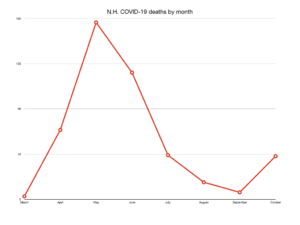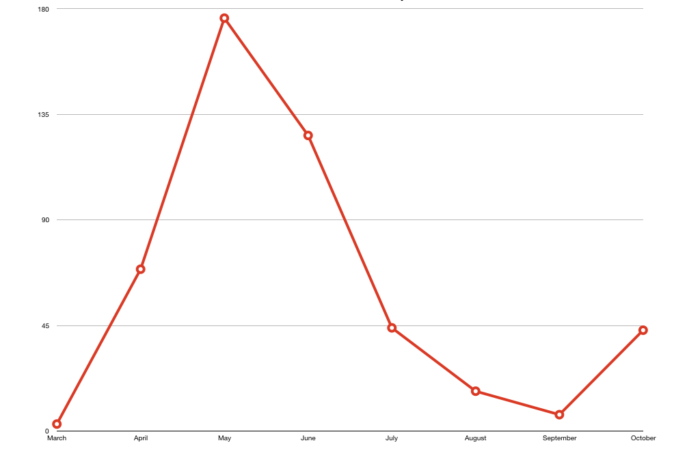October COVID numbers show that the virus is having a different impact than in the spring
In New Hampshire in October, new coronavirus infections, hospitalizations and deaths all spiked, but the virus had a less harmful impact than in the spring.
Though October infections set a record, hospitalizations and deaths remained far below their spring and early summer levels.
Positive test results totaled 2,799 in October, a 182.5% increase from September. The state’s previous high was 2,505 in May.

The state recorded 36 new hospitalizations in October, a 50% increase from September.
But September’s 24 new hospitalizations were the second-lowest since the start of the pandemic, leaving October’s hospitalizations far short of the numbers posted in the spring and early summer months.
October’s 36 hospitalizations were the state’s third-lowest monthly total. The state recorded more than 100 new hospitalizations in May, June and July, and more than 200 in April.

The state reported 43 new COVID-19 deaths in October, a tremendous 514% increase from September.
Yet September’s seven deaths were the lowest since the state recorded three in April. October’s deaths were the fourth-lowest monthly total since March. The state recorded 69 deaths in April, 176 in May, and 126 in June.
Every death in October was of a person age 60 or higher. In fact, no one under age 60 in New Hampshire has died from COVID-19 in September, October or to this point in November.

The state hit another record in October, conducting its highest number of COVID-19 tests. Total PCR tests reached 273,139 in the month, according to data collected from the state’s daily updates. That includes tests from the University of New Hampshire.
The total number of tests was 21,548 higher than what the state reported in September.*
October’s test positivity rate was 1.025%.
The October trend lines show that even though infections hit a record, the state was in better shape than in the spring, as the infection rate remained low and the infections resulted in less harm.
There is no definitive answer for why the virus is resulting in fewer hospitalizations and deaths than in the spring, but there are some theories.
An obvious factor is that younger, healthier people are being infected, resulting in lower hospitalization and death rates.
A Wayne State University study released in October found declining viral loads in infected people, possibly suggesting a weakening virus or increased masking and social distancing, resulting in people being infected by smaller doses of the virus.
Masking might be playing a strong role, as a July study published in the Journal of General Internal Medicine suggests. The study concluded that mask-wearing basically works to inoculate the wearer, resulting in an infection that causes few or no symptoms.
If this is true, it would mean that masking can help to reduce both the spread and the severity of the coronavirus. Though there is evidence to support the theory, it is not conclusive.
What is clear is that the virus has had a less deadly impact in New Hampshire so far this fall than it did in the spring and early summer.
In the first half of November, infections have continued their steep climb, and the infection rate is more than double October’s, yet deaths are trending down. New hospitalizations appear to be trending slightly upward, though not at the same rate as infections.
There is no guarantee that these trends will continue. It’s possible that as people move mostly indoors through the depths of the winter, symptomatic infections will spike, or larger percentages of older people will be infected, resulting in higher rates of hospitalization and death. But so far the fall has proven less deadly than many feared.
* The state’s September numbers did not include UNH tests for the first 17 days of the month. UNH does not list its tests per day, so we cannot determine precisely how many total tests were given in September. For that reason, we’re using the state’s reported figures.



